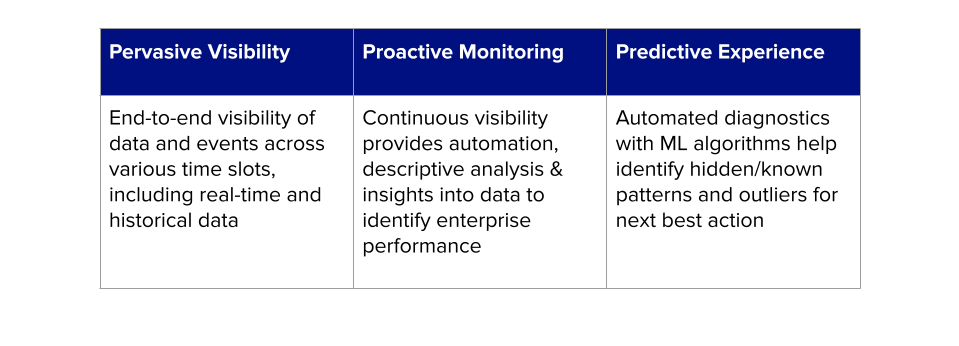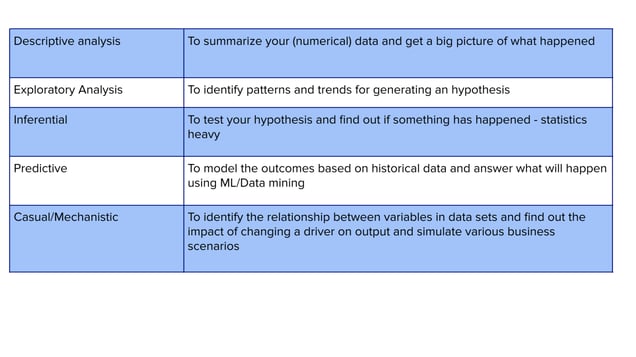People, devices, and data; these three entities are no longer monolithic in nature and do not exist independently. They operate as an extension of each other and are intricately intertwined. So, the deluge of data that has been generated from millions of people and devices has spurred the fanatical demand for cutting-edge data landscapes and analytics. To derive any business outcome, organizations must be able to make sense of such unstructured data. For that data needs to be processed or refined, governed and enabled for obtaining insights.
Organizations, irrespective of size, strive to be more data-driven and are consolidating their data silos, such as data warehouses, data lakes, and analytics applications, to the cloud . The consensus is unanimous and universal - it pays to be a data-driven organization. This is where data modernization plays a pivotal role, it helps in cutting across various data dimensions:

Essential Building Blocks of Data Modernization
Data modernization is not just limited to breaking silos in your business or moving core competencies to the latest and greatest cloud technologies. It is also about leveraging the humongous amounts of enterprise data to have a positive impact on the bottom line of your business.
The key parameters that constitute a successful data modernization plan are:
- Easily available information: Data, in its rawest possible form, does not serve any purpose for an organization. Business stakeholders need to have easy and quick access to unadulterated and consolidated information to make well-informed, fact-driven decisions. This kind of information should be made securely available for different stakeholders, irrespective of hierarchy, across different devices.
- Well-entrenched platforms: Fully functional data platforms should provide harmonious user experience, economical scaling, on-demand performance, powerful AI and analytics features, and so much more to ensure an organization’s potential to flawlessly leverage data in a secure and flexible manner. Such platforms must drive, instead of restrict, operational effectiveness and innovation.
- Vigorous data governance: Data-driven organizations and their modern systems require agile management and controls for the administration, application, and integrity of enterprise data. Data governance defines and establishes the processes and responsibilities that guarantees the caliber and security of the data being used across the organization. It sets in stone the kind of actions that a business stakeholder can take, the type of the data that can be leveraged, the circumstances that dictate such usage, and the methods that can be used.
- Airtight data security: Data, being one of the most crucial and prized assets of an organization, has to be secured and protected at all times. Data security is not limited to only digital protection for dormant or active data, but also includes physical security, business processes that prevent unsanctioned access, management of personally identifiable information, and incident response procedures.
The apt systems and processes must be in place to ensure that data is the catalyst behind business decision-making, reduction of costs, saving of workforce time and effort, and so much more. Data modernization is just the beginning; the next step in the transformation journey is to figure out how to extract value from your enterprise data.
Kick your Data Modernization ROI into High Gear
Technology-driven modernization permeates data integration and management with AI, subsequently empowering organizations to reap the benefits of intelligent data management through the cloud. Such permeation is extremely vital in leveraging the cloud to grow beyond old data integration methods that have no place in meeting today’s business goals.
AI-powered intelligence is essentially the cutting-edge, holistic data management foresight that organizations need. This will help them get the better of highly splintered, manually-dependent data preparation and data pipeline creation methods, transformative processes that lead to sluggish data life cycles, which inhibit them from attaining true data ROI.
Here are some of the ways that organization can implement to achieve significant ROI traction with intelligent and comprehensive data management:
- Break down data warehouse and data lake silos with cloud-native services
Organizations must take a step back and assess different options that can help form a unique, consolidated data architecture that exploits intelligent, cloud-native data management. As a result, they can sustain different kinds of workloads, at any given latency or scale, and on any cloud for all types of users. This could involve the merging of data silos for streamlined data management and access. - Refine data quality and precision through metadata insights
The data that provides insights about data is termed as metadata. It assists organizations to govern data better, enhance data quality and hasten the incorporation of new data. AI-powered intelligence and cloud-native competencies allow organizations to automate and expand metadata detection and management. Metadata falls under four categories - technical, business, operation & infrastructure, and usage. - Provide integrated data management to ensure robust & comprehensive data pipelines
All types of workloads need to have sturdy and exhaustive data pipelines and production processes; for example, BI dashboards, AI/ML development, data science, etc. Organizations can initiate automated data pipelines to ensure real-time large-scale data ingestion from varied sources into data lakes. Organizations require an end-to-end data platform to easily and keenly observe and organize various active data pipelines at different levels of ingestion (profiling, data cleansing, and transformation). Organizations can supply data much faster for different workloads at the same time, leading to increased productivity and user satisfaction. - Augment data governance and assurance through consolidated data integration and metadata intelligence
Organizations have to make sure that data governance processes make use of metadata assets efficiently. Also, the span of their metadata should extend across the complete hybrid, multi-cloud environment. Significant amounts of time and manual effort required to update data lineage records can be saved with AI-powered automation enabled in a consolidated data integration system. - Strike a balance between stability and agility
Organizations across the globe have been able to successfully implement agile methods and frameworks (DevOps, DataOps and MLOps) to remove the limitations of data silos and manage far-reaching development and operationalization. Apart from technology and dev best practices, these methods place huge importance on effective communication and collaboration between stakeholders from business, IT, data science, and development teams, which can fast-track the development and deployment of data pipelines during the data life cycle.
Data Monetization: Making Bank with Enterprise Information
Extremely competitive and inventive organizations are always on the lookout for new ways and means to increase their success in the world of business. With the arrival of cutting-edge data and analytics technologies, data is considered as a strategic and constantly evolving asset, which can successfully pave the way for new opportunities of revenue generation.
Enterprise data lakes, data warehouses, and various other platforms are filled to the brim with data assets that can be effectively and continuously monetized. Data monetization is the process through which organizations pivot their data assets to achieve new fiscal benefits. These new fiscal benefits can be in the form of new products or services, process improvements that lead to additional revenue, reducing operational costs, and so on. According to a Grand View Research report, the global data monetization (valued at $1.3 billion in 2019) is projected to grow at a CAGR of 24.1% from 2020 to 2027.
Here are the common ways that organizations monetize their data:
- Data distillation: Enterprise data, analyzed data, or any kind of assets gleaned from data, can be sold or licenced. The data (either raw, refined, or summarized) can be sold as independent records, a collection of records, or as part of a bigger collection of software, services, and products. Also, it can be offered as a one-time package of data or as a subscription.
- Data productization: Organizations can use their enterprise data or data assets to create revenue generating products or services, which they can sell, license, or provide on the basis of subscription to external customers.
- Data operationalization: Enterprise data can be used by organizations to positively impact business outcomes via data-driven processes or activities to substantially increase revenues and bring down costs.
Organizations must step up their game and bring together wayward, siloed data and invigorate their technology-driven data integration and management practices.
On the flip side, enterprise users demand quick, lucid, and secure access across different touchpoints in such diverse systems, which include multiple cloud platforms. They need access to such real-time data insights to quickly arrive at decisions that impact both short-term and long-term business goals.
There is more to data ROI than meets the eye
Revitalizing your data landscape is crucial for not just addressing constantly changing business requirements and keeping up with the demand for business-driven analytics, but also to remain relevant in the market, right now and in the future. As users gain more acumen about data, they will lean heavily on trusted data sets and expect the blending of new data sources to scrutinize different viewpoints and obtain contextual comprehension. While several methodologies are available to inspect, clean, transform and model the data sets, data experts at Srijan recommend to do these:
 Data serves as the cornerstone of internal and external collaboration and can help stakeholders in your business to make well-informed and synchronized decisions, as and when unforeseen business challenges arise.
Data serves as the cornerstone of internal and external collaboration and can help stakeholders in your business to make well-informed and synchronized decisions, as and when unforeseen business challenges arise.
As a data modernization partner, we can help you navigate through uncharted data landscape, assess your current data architecture, and help you adopt a more agile, streamlined, and responsive data ecosystem. To find out how you can achieve high ROI on your data investment, contact us right away.
Our Services
Customer Experience Management
- Content Management
- Marketing Automation
- Mobile Application Development
- Drupal Support and Maintanence
Enterprise Modernization, Platforms & Cloud
- Modernization Strategy
- API Management & Developer Portals
- Hybrid Cloud & Cloud Native Platforms
- Site Reliability Engineering




